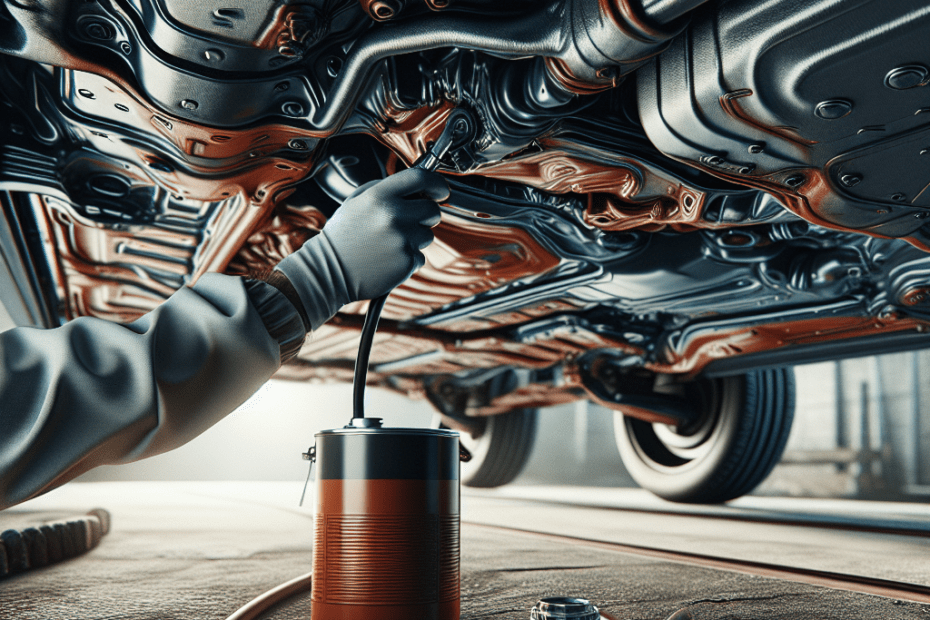“`html
Introduction
In regions where harsh winters and roads laden with salt are common, vehicles face the relentless issue of rust. Many car owners find themselves wondering how to prevent car rust effectively, ensuring the longevity and aesthetics of their beloved vehicles. Rust is more than just a cosmetic issue; it compromises the car’s structural integrity if left unchecked. One of the most effective methods to combat this problem is through undercoating. This blog will delve into how undercoating can be a game-changer in preventing rust and keeping vehicles in top shape.
Understanding Car Rust
A car’s battle against rust is primarily due to steel’s exposure to oxygen and moisture, leading to oxidation. According to a study by the Automotive Association, nearly 70% of serious car damages are related to rust. This is particularly prevalent in areas where roads are routinely salted during winter months. Road salt significantly speeds up the rust formation process, but rust can also occur in drier climates due to humidity and air moisture.
What is Undercoating?
Undercoating is a protective layer applied to the underbody of a car. This layer acts as a barrier between the vehicle’s metal components and environmental elements like water, road salt, and dirt. By blocking these elements, undercoating effectively slows down the corrosive process, ultimately helping to prevent car rust.
Types of Undercoating Available
There are various types of undercoating, each with its unique advantages:
| Type | Description | Durability |
|---|---|---|
| Rubberized Undercoating | Offers a flexible layer that also dampens noise. | Moderate to High |
| Polyurethane Undercoating | Forms a hard shell, protecting against chips and moisture. | High |
| Wax/Paraffin-based Undercoating | Provides a cost-effective barrier; easy to apply. | Low to Moderate |
| Asphalt-based Undercoating | Best for heavy-duty vehicles; provides a durable, waterproof barrier. | Very High |
Steps to Undercoat a Car
The process of undercoating a car requires careful preparation and application. Here are the recommended steps:
- Clean the Underbody: Remove any dirt, debris, and rust from the car’s underbody. Use a power washer or detergent solution for best results.
- Inspect for Rust: Address any existing rust spots by sanding them down or using a rust converter.
- Mask Sensitive Areas: Cover exhaust pipes, engine parts, and other heat-sensitive components to avoid coating build-up.
- Apply the Undercoat: Use a spray gun for uniform application. Ensure a thick and even layer is applied to all exposed parts.
- Cure the Undercoat: Allow it to cure for at least 24 hours before driving the vehicle to ensure maximum effectiveness.
The Benefits of Undercoating
Undercoating offers several benefits, beyond just rust prevention. It serves as a protective shield against:
- Road Noise Reduction: Undercoating can significantly reduce road noise, making for a quieter driving experience.
- Resale Value: Vehicles with undercoating tend to maintain a better resale value due to their enhanced longevity and reduced rust issues.
- Investment in Longevity: The initial investment in undercoating can lead to long-term savings by avoiding costly rust repairs.
Key Takeaways
- Rust is a common problem for vehicles, particularly in areas with harsh weather conditions.
- Undercoating acts as a protective barrier against rust and environmental elements.
- Different types of undercoating include rubberized, polyurethane, wax-based, and asphalt-based, each with varying levels of durability.
- Proper application of undercoating involves cleaning, prepping, and methodical application.
- Undercoating not only prevents rust, but also reduces road noise and enhances vehicle value.
FAQ
- What is undercoating and why is it important?
Undercoating is a protective barrier applied to a car’s underbody to prevent rust. It’s important because it prolongs the vehicle’s life and protects against environmental damage. - How often should I apply undercoating to my car?
Undercoating should be reapplied every few years, though it’s best to consult with the manufacturer or a professional for specific intervals based on climate conditions. - Does undercoating help with noise reduction?
Yes, one of the additional benefits of undercoating is that it can dampen road noise, resulting in a quieter ride. - Can I do undercoating myself, or should it be done professionally?
While DIY undercoating kits are available, having it done professionally ensures even coverage and proper application, which may justify the cost for many car owners. - Is undercoating effective for older vehicles?
Yes, undercoating can still be beneficial for older vehicles, especially if it helps to address minor existing rust and protect against further damage.
“`
This HTML blog post provides an in-depth look at how undercoating can prevent car rust, furthermore incorporating data-backed insights and practical advice for readers. By following these steps and utilizing suitable undercoating techniques, car owners can keep their vehicles in excellent shape while protecting their investments.
